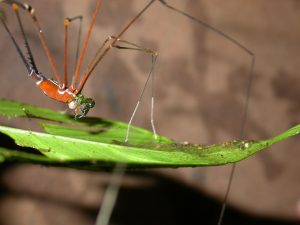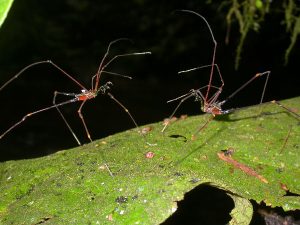An overview of Alissa et al. (2017)
The debate over parental responsibility is a contentious one in our human society. Who should get parental leave? Whose responsibility is child protection and education? Such questions are often aimed at trying to get men more involved in the caring of a child or to split responsibility more evenly between two parents. Who would have thought that similar questions are being asked about spider societies?
It turns out that those intriguing 8-legged creatures that have plagued people’s nightmares and inspired fantasy from Charlotte’s Web to Harry Potter, also have very complex family dynamics. For most wild creatures the main purpose in life is to reproduce as successfully as possible. Thus, in some species, such as the harvestman spider, Serracutisoma proximum, investigated by Alissa et al. (2017), we see a trade-off between energy and time investment in mating effort and offspring care.
This parental investment trade-off theory, first proposed in a fundamental 1972 paper by Robert Trivers (Trivers, 1972), states that if females invest more time and energy onto rearing offspring, it is in the males’ best interest to invest the majority of their time and energy into successfully outcompeting other males when finding mates, and that these differences are based in the difference between male and female investment in gametes (eggs and sperm). Such trade-offs have been observed in species ranging from insects to birds and similar topics are explored in humans (Lawson and Mace, 2011). This fight for mates on the males’ part can take the form of direct competition between males for access to females or attempts to outcompete each other to win the favor of choosy females. For example, sierra dome spider males fight violently between each other, often to the death, to access females (Watson, 1990) while black widow spider males take explicit action to make females less attractive (Scott et al., 2015). Some species also express male choice in mating (Hoefler, 2007; Reichert and Singer, 1995). Often a combination of these processes is at play, and the interactions can be complex (Lane et al., 2016; McGhee et al., 2007; Setchell 2016). Also, more recent research argues against this standard model and suggests that the gametic difference between males and females may in fact not be the driver of parental care differences (Kokko and Jennions, 2008; Liker et al., 2015).
However, Trivers’ theory still forms the basis of our understanding and stands as a model for evolutionary biologists to work from. Therefore, Trivers’ theory, and decades worth of evidence that followed, led Alissa et al. to investigate the mating patterns of S. proximum, a species of harvestman spider found in Brazil (Figure 1). Based on theoretical models Alissa et al. assumed that the especially attractive males with a high competitive advantage in mate-finding and territory defense (major males) should invest more energy and time in mating effort as here they have a good chance of success. On the contrary, males that are less attractive to females, and are thus disadvantaged in mating competition (minor males), should invest more in parental care (Figure 2). In S. proximum, females lay and take care of eggs, while a male guards a harem of these-nest protecting females. However, if the females are killed, males of this species will take over parental duties.


The allocation of males to mating or offspring care is influenced by many factors. Alissa et al. predicted that when they removed females from their eggs, more attractive males would be less likely to step in and take over, while the perceived quality of the offspring would make males more likely to take on this role (see below). Furthermore, they predicted that upon removal of females, egg mortality would increase with a decrease in male paternal care.
Critical to this investigation was quantifying male attractiveness and perceived offspring quality by the males, as this was expected to impact whether or not males would take over care after females were removed. Male attractiveness was measured by the number of new females visiting a harem, and this also gave the males a measure of their own probability of acquiring mates. To quantify offspring value, the number and age of eggs was recorded. They interpreted male awareness of offspring value and paternity by measuring the proximity of males to the females and eggs they were guarding. Male care was then quantified by the number of times a harem-owning male was observed taking care of the clutch of eggs after the female was removed.
So what did they find?
Alissa et al. confirmed their prediction that attractive males were less likely to take over paternal care roles and that males seemed to determine their attractiveness by their recent mating rate. They also found that the number of eggs and perceived paternity increased the performance of paternal care. However they did not find that egg survival was higher with increased paternal care as they had expected. In fact they found that males taking care of the eggs did not stop other females from cannibalizing the eggs, and sometimes even copulated with newcomer females while other females cannibalized the eggs. This suggests that they allow the cannibalism to increase their mating possibilities with females to whom they owe no guarding responsibilities. Alissa et al. concluded that there will not be an evolutionary trend towards exclusive paternal care in this species. Only if males could guard the clutch while maintaining copulation possibilities and if females could leave a clutch without a risk of cannibalism on their eggs while raising a next clutch, could such an evolutionary trend occur. According to Alissa et al. theirs was the first research to test recent models of parental care evolution in an invertebrate species. Thus the main implication of their results was that the evolution of exclusive parental care can only occur if the trade-off between mating effort and parental care is avoided.
Potential Future studies
Despite the lack of an apparent evolutionary trend for or against paternal care, Alissa et al. found that males used their recent mating history and perceived paternity to weigh the benefits and adjust their investment in territory defence and egg care. They suggested that future studies should investigate how exclusive paternal care has evolved in other species, especially considering that exclusive paternal care has developed in other arthropods and amphibians, and how they balance temporal trade-offs. If this species is compatible to a laboratory environment it would be interesting to see if the evolutionary predictions made by Alissa et al. would hold true in a manipulated setting where conditions were created to mimic those that they expect would allow for the evolution of exclusive paternal care. If they could observe a trend in that direction, they could then use that as a model to make further predictions.
Further Reading
Buzatto, B.A., Requena, G.S., Lourenco, R.S., Munguia-Steyer, R., and Machado, G. 2011. Conditional male dimorphism and alternative reproductive tactics in a Neotropical arachnid (Opiliones). Evolutionary Ecology 25: 331-349. DOI: 10.1007/s10682-010-9431-0
- Looks at the effects of sexual selection, the development and genetic basis of male dimorphism in Serracutisoma proximum, as well as the effects of this on mating success and behaviour.
Kokko, H. and Jennions, M.D. 2008. Parental investment, sexual selection and sex ratios. Journal of Evolutionary Biology 21(4): 919-948. DOI: 10.1111/j.1420-9101.2008.01540.x
- A review of the ideas proposed by Trivers, exploring our more current understanding of sex roles and parental investment as well as their evolutionary basis and origins.
Munguia-Steyer, R., Buzatto, B.A., and Machado, G. 2012. Male dimorphism of a neotropical arachnid: harem size, sneaker opportunities, and gonadal investment. Behavioral Ecology 23: 827-835. DOI: 10.1093/beheco/ars037
- An examination of male characteristics in Serracutisoma proximum relating to sexual selection.
Stiver, K.A. and Alonzo, S.H. 2009. Parental and mating effort: is there necessarily a trade-off? Ethology 115: 1101-1126. DOI: 10.1111/j.1439-0310.2009.01707.x
- A re-examination of Trivers’ fundamental ideas. Suggests that too much emphasis has been placed on the trade-off between mating and parental effort and proposes that the relationship is much more complex than it may appear.
Trivers, R.L. 1972. Parental investment and sexual selection. In: Sexual Selection and the Descent of Man (B. Campbell, ed), pp. 136-179. Aldine, New York, NY. https://joelvelasco.net/teaching/3330/trivers72-parentalinvestment.pdf
- Seminal paper from the forerunner of thinkers about parental investment. Proposed many of the concepts that are standard in evolutionary thought today, an extensive review of wide-ranging evidence.
van Strien, W. (2016, Nov 24). Too busy to care: a successful daddy longlegs is a bad dad. From so simple a beginning. Retrieved from https://blog.willyvanstrien.nl/2016/11/24/too-busy-to-care/
- A short blog post based on this same paper by Alissa et al.
References
- Alissa, L.M., Muniz, D.G., and Machado, G. 2017. Devoted fathers or selfish lovers? Conflict between mating effort and parental care in a harem-defending arachnid. Journal of Evolutionary Biology 30: 191-201. DOI: 10.1111/jeb.12998
- Hoefler, C.D. 2007. Male mate choice and size-assortative pairing in a jumping spider, Phidippus clarus. Animal Behaviour 73(6): 943-954. DOI: 10.1016/j.anbehav.2006.10.017
- Kokko, H., and Jennions, M.D. 2008. Parental investment, sexual selection and sex ratios. Journal of Evolutionary Biology 21(4): 919-948. DOI: 10.1111/j.1420-9101.2008.01540.x
- Lane, S.M., Dickinson, A.W., Tregenza, T., and House, C.M. 2016. Sexual Selection on male cuticular hydrocarbons via male-male competition and female choice. Journal of Evolutionary Biology 29(7):1346-55. DOI: 10.1111/jeb.12875
- Lawson, D.W. and Mace, R. 2011. Parental investment and the optimization of human family size. Philosophical Transactions of the Royal Society of London B: Biological Sciences 366(1563): 333—343. DOI: 10.1098/rstb.2010.0297
- Liker, A., Freckleton, R.P., Remeš V., Székely, T. 2015. Sex differences in parental care: Gametic investment, sexual selection, and social environment. Evolution 69(11): 2862-2875. DOI: 10.1111/evo.12786
- McGhee, K.E., Fuller, R.C., and Travis, J. 2007. Male competition and female choice interact to determine mating success in the bluefin killifish. Behavioral Ecology 18(5): 822-830. DOI: 10.1093/beheco/arm051
- Reichert, S.E. and Singer, F.D. 1995. Investigation of potential male mate choice in a monogamous spider. Animal Behaviour 49(3): 715-723. DOI: 10.1016/0003-3472(95)80204-5
- Scott, C., Kirk, D., McCann, S., and Gries, G. 2015. Web reduction by courting male black widows renders pheromone-emitting females’ webs less attractive to rival males. Animal Behaviour 107: 71-78. DOI: 10.1016/j.anbehav.2015.06.009
- Setchell, J.M. 2016. Sexual Selection and the differences between the sexes in Mandrills (Mandrillus sphinx). American Journal of Physical Anthropology 159(Suppl 61):S105-29. DOI: 10.1002/ajpa.22904
- Trivers, R.L. 1972. Parental investment and sexual selection. In: Sexual Selection and the Descent of Man (B. Campbell, ed), pp. 136-179. Aldine, New York, NY. https://joelvelasco.net/teaching/3330/trivers72-parentalinvestment.pdf
- Watson, P.J. 1990. Female-enhanced male competition determines the first mate and principal sire in the spider Linyphia litigiosa (Linyphiidae). Behavioral Ecology and Sociobiology 26: 77-90. DOI: 10.1007/BF00171577
